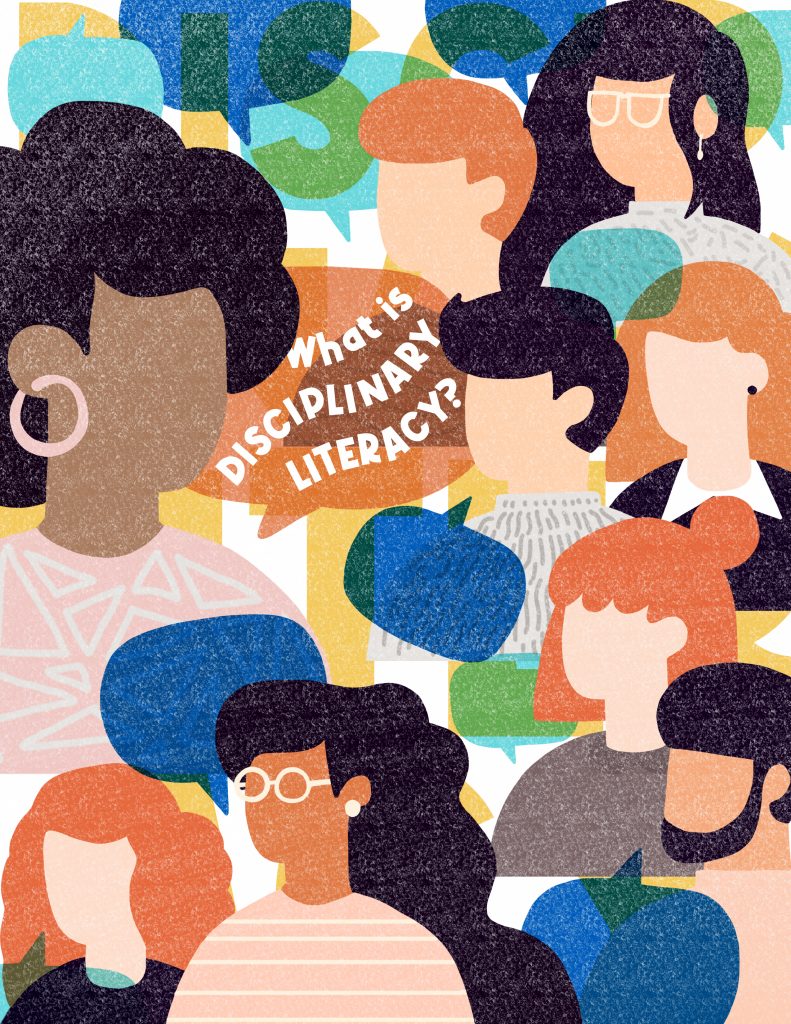Language is an integral part of science literacy. Language in science emphasizes the need for students to communicate and be actively involved in the public discourse of science to be able to relate scientific issues to technology, society, and the environment. In his seminal 1998 paper, J.L. Lemke (1) states:
“…to do science, to talk science, to read and write science it is necessary to juggle and combine in various canonical ways verbal discourse, mathematical expression, graphical–visual representation, and motor operations in the world” (87).
Reading, writing, and verbal communication are critical for the construction of scientific understandings. In science classrooms, there is a general emphasis on the empirical nature of science which, although important, suggests to students that mathematics is the only language of science. When this conception is extended to research and media platforms where science is represented to the public, it becomes apparent that equally important to empirical evidence is the language used in science to construct and present scientific claims and arguments.
What is disciplinary literacy?
Disciplinary literacy “is aimed at learning how to read, think about, write, communicate, and use information like each discipline’s experts; that is, like an artist (arts), a mathematician (math), a scientist (science) or an historian (social studies)” (2). The coupling of disciplinary literacy with the goals of science education involves the skills of reading, writing, thinking, and communicating to learn the content and develop the habits of mind specific to the discipline of science.
Supporting students in developing disciplinary literacy skills provides the content knowledge the students need to read and write scientific texts as well as to learn through and about the scientific discourse to develop critical thinking skills, reasoning skills, and sense-making of scientific concepts. A disciplinary literacy approach to content allows students to engage with science in ways that reflect how knowledge is constructed and how arguments are developed.
The Next Generation Science Standards (NGSS) and the K-12 Framework in Science Education by the National Research Council (NRC, 2012) share common emphases on incorporating disciplinary literacy in K-12 science education. The NGSS standards identify key literacy connections to the Common Core State Standards for Literacy in Science and Technical Subjects.
Standard 6 states: (3)
“Science and Engineering Practice: Obtaining, Evaluating, and Communicating Information
Any education in science and engineering needs to develop students’ ability to read and produce domain-specific text. As such, every science or engineering lesson is in part a language lesson, particularly reading and producing the genres of texts that are intrinsic to science and engineering.” (NRC Framework, 2012, 76)
Literacy must be embedded in meaningful content instruction. Instead of approaching literacy as an instructional add-on to the curriculum, disciplinary literacy aligns with the existing science learning goals. Discipline-specific reading allows students to navigate layers of meaning, to clarify content, to practice comprehension strategies, to consolidate learning, and to make connections to other related topics.
Literacy and inquiry share important characteristics and are equally important for students’ acquisition of scientific understanding. For instance, reading in science is an inquiry process. The language of science can present both the science content and the scientific enterprise. Investigative activities require literacy skills such as the ability to use scientific terminology, comprehend scientific texts, engage in critical reading, and write scientific explanations based on reasoning and evidence. Evidence-based arguments require students to be proficient readers and writers. As Pearson et al. (2010, 460) explain: (4)
“Students fine-tune their literacy tools not only when they read and write science texts, but also when they engage in science investigations precisely because so many of the sense-making tools of science are consistent with, if not identical to those of literacy, thus allowing a setting for additional practice and refinement that can enhance future reading and writing efforts.”

How can educators incorporate reading and writing in the science classroom to emphasize disciplinary literacy?
- Anticipation Guides
Utilizing pre-reading tools is an effective strategy that prepares students to read and write through inquiry in the science classroom. Pre-reading tools allow students to critically engage with the text for sense-making, questioning, and developing complex subject-area learning. One example is using anticipation guides to stimulate students’ interest and set a purpose for reading (5). Anticipation guides may be used with different texts including ‘science in the news’ articles.
2. Lab Reports
Another approach is replacing the headings in a lab report with questions (6). Instead of using hypothesis, procedure, observations, results, and discussion, students can answer questions such as:
- What is my question?
- What did I do?
- What did I see?
- What is my claim?
- What is my evidence?
- What do secondary resources say? (books, experts)
- Did I change my ideas?
The laboratory activity becomes an opportunity for students to construct a richer understanding of the concept behind the activity. The verbal communication that occurs during classroom instruction, laboratory activity, and small group discussions can serve as a learning tool for students to develop disciplinary literacy.
3. Trade books
Trade books authentically portray science and provide students with a wide range of reading material that varies in content, genre, and format. The National Science Teachers Association (NSTA) compiles a list of quality science trade books that are scientifically accurate, up-to-date, logical, and devoid of stereotypes (7). The annual list is called the Outstanding Science Trade books for Students K-12 (8) and contains about 40 books. Teachers can assign a trade book for students to read that aligns with a specific unit and then encourage students to form book discussion groups, a book club, or a science reading program.
What are the challenges?
The dominant approach to disciplinary literacy in science classrooms is adopting a knowledge-telling model in which students mechanically recollect and retell conceptions of science. Teachers evaluate students’ understanding using short-answer responses. Research refers to such writing tasks as ‘replication of the norm’ (6) that rarely go beyond the duplication of knowledge. Alternatively, reading and writing to learn science might include description (scientific reports), explanation (causation and correlation), and/or argumentation (report with claims, warrants, and evidence).
Disciplinary literacy does not mean abandoning rigorous coursework. Disciplinary literacy is often overlooked because of the heavy emphasis on teaching content and the empirical nature of science. Nonetheless, using a disciplinary literacy approach to emphasize concepts and ideas provides a rich learning environment. Meaningful content-area learning from science texts can be a significant aid to both science learning and reading comprehension.
Teachers often find it challenging to integrate disciplinary literacy skills into their instruction because of time constraints and/or limited knowledge of how to introduce and integrate disciplinary literacy skills into their instructional plans without compromising disciplinary content learning. In a teacher-led environment, it is difficult to balance literacy skills with whole-class direct instruction directed at mastering the content and reproducing it in an assessment.
Disciplinary literacy can be one of the core objectives of science education because reading, interpreting, and producing text are fundamental practices of science (9) and are inherently linked to science literacy. Science literacy is essential at times where misinformation is rampant, and pseudoscience is masquerading as authentic science. Science education prepares students to effectively implement their understanding of science in daily life and to practice their role as socially responsible citizens. Our democracy and future depend on literate citizenry capable of reasoning, inquiry, and participating in the demands of the 21st century.
Additional Resources
- https://www.amnh.org/learn-teach/curriculum-collections/integrating-literacy-strategies-into-science-instruction
- https://www.readingrockets.org/extras/stem_series
- https://edu.rsc.org/resources/collections/literacy-in-science-teaching
- http://det.wa.edu.au/stepsresources/detcms/navigation/first-steps-literacy/
References
- https://www.researchgate.net/publication/246905867_Multiplying_meaning_Visual_and_verbal_semiotics_in_scientific_text
- Zygouris-Coe, V. I. (2012). Disciplinary literacy and the common core state standards. Topics in Language Disorders, 32(1), 35–50.
- https://www.nextgenscience.org/get-to-know
- Pearson, P. D., Moje, E., & Greenleaf, C. (2010). Literacy and science: Each in the service of the other. Science (New York, N.Y.), 328(5977), 459–463. doi:10.1126/science.1182595
- https://letstalkscience.ca/educational-resources/learning-strategies/anticipation-guide
- Examining the literacy component of science literacy: 25 years of language arts and science research
- Disciplinary Literacy in Science Developing Science Literacy Through Trade Books
- https://www.nsta.org/outstanding-science-trade-books-students-k-12
- https://www.nap.edu/catalog/13165/a-framework-for-k-12-science-education-practices-crosscutting-concepts

















